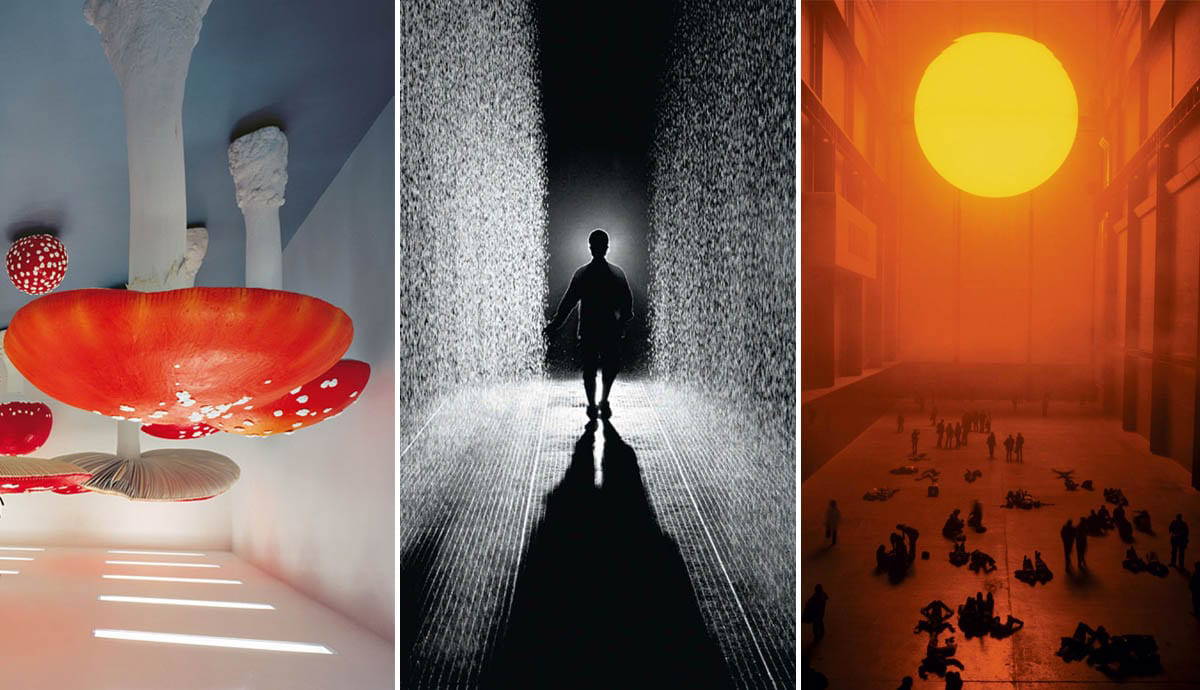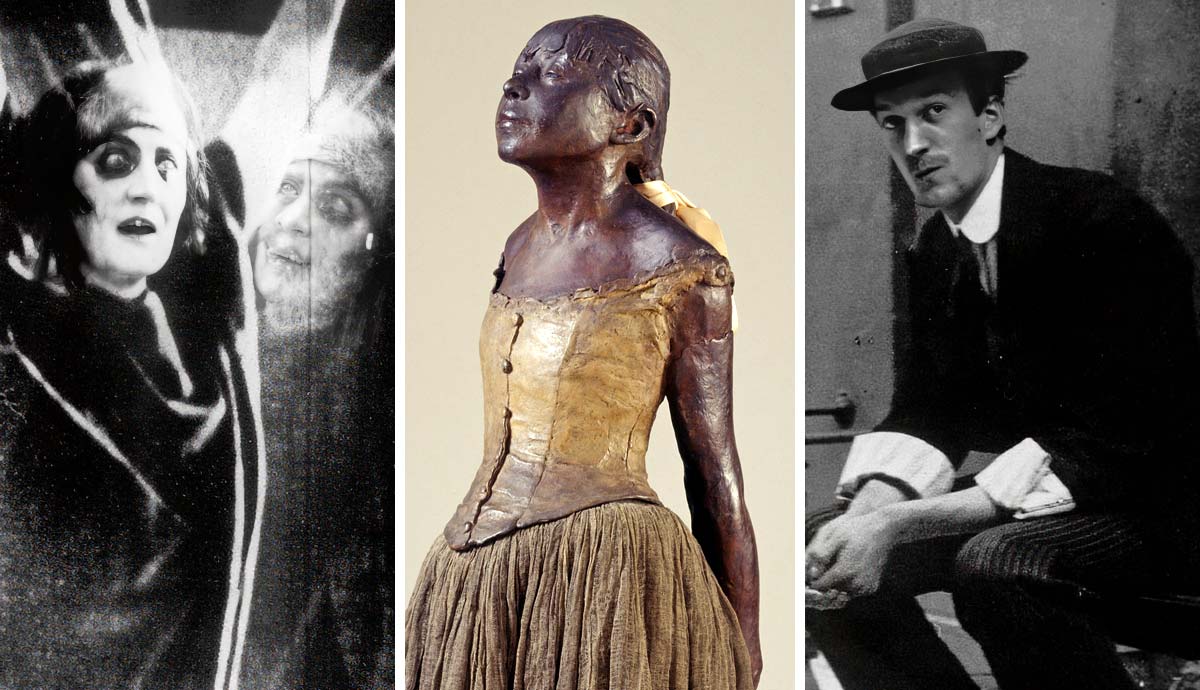
Installation art is one of the most powerful and immersive of all art forms. In contrast with traditional mediums such as painting and sculpture, installation art is designed to fill whole rooms or even entire gallery spaces. Emerging as a bona fide art movement in the 1960s, installation art has since become one of the most popular and widespread strands of contemporary art practice, with artists embracing ever more adventurous and playful ways of transforming the gallery experience.
Many artists design tailor-made installation art to fit into a certain space, changing it into an entirely new arena. Scaffolding, false walls, mirrors, and even entire playgrounds have filled contemporary art spaces, while light and sound effects are also a common feature. Audience interaction is a vital aspect of installation art; visitors have been encouraged to crawl under huge towers, squeeze past giant mushrooms, or trigger sensors with the movement of their body. The rise of digital technology has undoubtedly impacted this interactive strand of installation art, offering artists a vast wealth of new possibilities like never before.
This article provides a brief history of installation art and shares ten artworks that define the genre.
A Brief History of Installation Art

Installation art arose as an art movement in the early 1960s, but before then the seeds had already been sown. In 1923 Russian Constructivist El Lissitsky first explored the interaction between painting and architecture with his world-renowned Proun Room, where two and three-dimensional geometric shards interact with one another in space. Ten years later German Dada artist Kurt Schwitters began making his ongoing series of constructions titled Merzbau, 1933 from assembled panels of wood that seem to grow outwards from the walls. French Surrealist and Dada artist Marcel Duchamp was also one of the first to playfully experiment with how visitors navigate a gallery space by filling it with a complex web in Mile of String, 1942.

In the 1950s ‘happenings’ were all the rage across the United States, with artists including Claes Oldenberg and Allan Kaprow merging experimental performance art with crudely assembled objects, often with a politicized agenda. By the 1960s the term ‘installation art’ had been adopted by leading publications including Artforum, Arts Magazine and Studio International to describe a huge rising trend for assemblages and environments. These artworks deliberately evaded the art market, since they were almost impossible to sell and had to be taken apart at the end of the exhibition. Instead, they have lived on through photographic documentation, known as an ‘installation shot.’
Since this time installation art has remained a mainstay of contemporary art practice and it is more diverse and experimental than ever. From prismatic displays of digital data to teetering towers on the brink of collapse, here are some of the most revolutionary and influential installations from throughout art history.
1. Allan Kaprow, Yard, 1961

American artist Allan Kaprow’s Yard, 1961, signaled a new era in art history. The artist filled the outdoor backyard of New York’s Martha Jackson Gallery to the brim with black rubber auto tires and tarpaper-wrapped forms before inviting willing participants to climb, jump and frolic like children in this giant playground. His iconic installation art opened up new, sensorial experiences for visitors and allowed them to engage with art like never before. As well as exploring abstract ideas around solids and voids in space, Kaprow also brought improvisation and group participation into his art, taking it closer to the reality of ordinary life, as he explains, “Life is much more interesting than art. The line between art and life should be kept as fluid, and perhaps indistinct, as possible.”
2. Joseph Beuys, The End of the Twentieth Century, 1983-5

A giant of twentieth-century art, German sculptor Joseph Beuys made The End of the Twentieth Century, 1983-85 just a year before he died. Thirty-one hulking rocks of basalt rock were gathered together and strewn across the floor to create this installation art, each with its own unique sense of history, weight and character. Into each rock, Beuys drilled away a cylindrical hole in which he stuffed clay and felt. He then polished and reattached the drilled away pieces, leaving only the slightest trace of his artistic intervention in each one. In doing so, he collapsed together old/new, natural/man-made and difference/repetition. Beuys also referenced the dawn of a new century still weighed down by history as heavy as his basalt rocks, commenting, “This is the end of the twentieth century. This is the old world, on which I press the stamp of the new world.”
3. Cornelia Parker, Cold Dark Matter: An Exploded View, 1991

British artist Cornelia Parker’s Cold Dark Matter: An Exploded View, 1991, is one of the most striking and memorable installation artworks of recent times. To create this work, Parker filled an old shed with domestic junk including old toys and tools, before having the entire shed exploded in a field by the British Army. She then gathered together all the fragments left behind and suspended them mid-air as if permanently suspended in the ‘b’ of the bang. When set amidst eerie lighting these once familiar items become abstracted and unrecognizable fragments, while the title ‘Cold Dark Matter’ further emphasizes a sense of gothic mystery, referencing what Parker calls, “matter in the universe that hasn’t yet been measured.”
4. Damien Hirst, Pharmacy, 1992

Designed to resemble the cool, clinical atmosphere of an old-fashioned pharmacy, Damien Hirst’s Pharmacy, 1992 contains a vast arrangement of pill packets, bottles and medical instruments set amidst an austere white backdrop. But his installation art is far too geometric and ordered to be real, with boxes and packages arranged into a neatly gridded system to resemble the clean purity of Minimalist art. Arranging pill packets into repeat patterns of enticingly bright colors highlights the seductive nature of pharmaceutical products, lending them all the desirability and danger of a sweet shop. This seductive quality of Hirst’s installation highlights our modern-day obsession with medicine as a tool to extend our life expectancy without question, as Hirst explains, “We all die, so this kind of big happy, smiling, minimal, colorful, confident facade that medicine and drug companies put up is not flawless – your body lets you down, but people want to believe in some kind of immortality.”
5. Carsten-Höller, Mushroom Room, 2000

With all the magical mystery of a childhood fairy-tale, Belgian artist Carsten Holler’s Mushroom Room, 2000 is a treat for the senses. Holler deliberately selected the red-and-white agaric fungus because of its psychoactive qualities, grossly exaggerating their size, colors, and textures to amplify their dramatic impact. Suspending them from the ceiling upside down forces visitors to squeeze and duck their way through them, turning this installation art into an interactive experience that engages the entire body and mind. Holler likens the transformative power of these mushrooms to the act of viewing and interacting with a work of art, arguing both can induce the same mind-altering experience of imaginative awakening that is at the core of creative thinking.
6. Olafur Eliasson, The Weather Project, 2003

Danish-Icelandic artist Olafur Eliasson designed his impressively ambitious installation artwork The Weather Project, 2003 for Tate Modern’s Turbine Hall, replicating the effect of a huge sun emerging through a fine mist. Low-frequency lamps around his artificial sun allowed only the golden glow of the sun to dominate the space, reducing all surrounding colors to the magical shades of gold and black. Master of illusion, Eliasson made his glowing orb from a semi-circle of light which is reflected by mirrored panels on the ceiling that complete the circle, lending the upper half of the sun a hazy, shimmering quality that mimics the real sun. These mirrored panels continued across the entire ceiling, allowing visitors to see themselves reflected as if floating in the sky above them, creating the sensation of hovering weightlessly in space.
7. Anish Kapoor, Svayambh, 2007

Described by art critic Adrian Searle as “a very fine mess,” British-Indian sculptor Anish Kapoor’s Svayambh, 2007, is both ludicrous and astonishing. Made from 30 tonnes of soft wax and pigment, a slow train moves back and forth on a specially designed track between the pristine arches of the museum (he has made several versions for different institutions) leaving in its wake an unbelievably messy trail of sticky, gooey matter. Kapoor’s installation art ‘train’ is a colossal 10 meters long and ignites our senses on numerous levels, through texture, surface, smell, and color; the distinctive shade of primitive red seen in this and many of his other works seems tied to our most basic and fundamental human instincts.
8. Yayoi Kusama, Infinity Mirrored Room – The Souls of Millions of Light Years Away, 2013

Japanese artist Yayoi Kusama’s Infinity Mirrored Room – The Souls of Millions of Light Years Away, 2013 is one of many immersive ‘Infinity Rooms’ which have fascinated gallery-goers around the world. Made by installing mirrored panels around the walls, ceiling, and floors of a small, enclosed space, Kusama then fills it with tiny networks of colored lights or objects that refract around the room and create the effect of endless, infinite space. Visitors entering her room walk along a mirrored walkway and see prismatic reflections of themselves scattered all around the room, surrounded by colored light. Much like entering a star-filled universe or merging into the digital superhighway, there’s nothing quite like the experience of an Infinity Room.
9. Random International, Rain Room, 2013

Random International’s much-celebrated installation artwork Rain Room, 2013, concisely merges art and technology into one. Visitors can pass through a gushing torrent of rainwater but miraculously remain dry, as sensors detect their movement and cause the rain to stop around them. This deceptively simple idea from the London-based collective embraces a natural symbiosis between art and viewer as the installation only comes alive through physical engagement. The artists of Studio International also tap into the fundamental role of technology in harnessing and stabilizing our natural environment, suggesting we can have a positive and mutually beneficial relationship with our landscape, rather than exploiting it for personal short-term gain. Made for temporary gallery spaces around the world, the first permanent installation of Rain Room was installed at the Sharjah Art Foundation in the United Arab Emirates in 2018.
10. Phyllida Barlow, Dock, 2014

In Phyllida Barlow’s Dock, 2014, made for Tate Britain, a series of huge haphazard assemblages made from found debris are nailed together and suspended around the room. Piles of scrap wood are hastily tacked together to form flimsy-looking scaffolding, onto which bundles of brightly colored fabric, old trash bags, and discarded clothing are bound with reams of colored tape. There is something ridiculously playful and appealing about Barlow’s knocked-up arrangements, tapping into a child-like desire to construct something from nothing. But more importantly, the sense of urgency and flux her upcycled arrangements create seems to reflect the anxious instability of living in the contemporary urban environment.
The Legacy of Installation Art

Since its conception, installation art has remained one of the most dominating mediums of contemporary art. With advancing technologies, more artists are now focussing on interactive digital installations, and this advancement has opened doors to entirely new possibilities for installation art and its relevance in today’s society. Its unifying power and immersive connection with the viewer makes installation art a revelation that continues to constantly reinvent itself.









